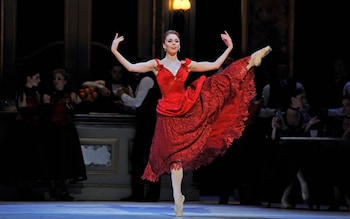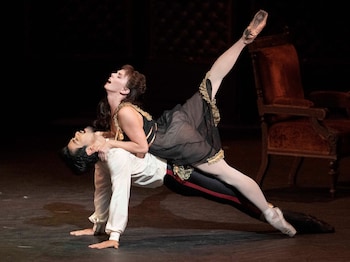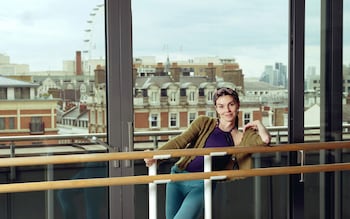
Star ballerina Natalia Osipova: ‘The Russian critics said I looked like Quasimodo’
The Royal Ballet principal turned her back on the toxic politics of the Russian ballet. Now living in London, she no longer feels ‘broken’

“A hot head and a cold brain! It has taken me almost 20 years to learn that is what I need to dance well and enjoy performing,” says Natalia Osipova, principal ballerina of the Royal Ballet. “But it wasn’t always easy for me to find that balance and I used to tear myself apart, make myself sick with the drama. Now, before I go on stage, I pray to God and I ask him to help me control that energy.”
Hailed by Telegraph dance critic Mark Monahan as a woman who “defies gravity more completely and more serenely than any other ballerina I have ever seen”, 38-year-old Osipova is poised to launch herself into a new season at Covent Garden, where she will star in Swan Lake and take on the “regal, magical” role of Titania in The Dream – British choreographer Frederick Ashton’s witty and tender reimagining of Shakespeare’s A Midsummer Night’s Dream – for the first time in a decade.
Today she meets me fresh from a coaching session with Darcey Bussell, tosses her tutu into the corner of a small office at the Royal Opera House, squats frog-like on a plastic chair and reminds me that when she started out at the Bolshoi Ballet in Russia in 2004, she was more of “a volcano, a girl with a sometimes destructive power, you know? The male dancers would look at me and think: ‘I don’t know how to work with that. How do you catch a tornado?’”
Born in Moscow in 1986, Osipova was a wild, unpredictable spirit, a tomboy who spent her early years falling out of trees and breaking windows. Her father, an engineer, had excelled in karate as a younger man and he encouraged her to push her physicality. She dreamed of a career in gymnastics but a couple of nasty falls prompted her parents to shunt her away from the beam and towards the ballet barre. When I interviewed her in 2021, she told me that she began dancing at the age of five and was already en pointe – “leaping around like a tiny horse” – by the time she was six.

At eight she began serious training at the Mikhail Lavrovsky Ballet School and from 1995 to 2004 she trained at the Moscow State Academy of Choreography, where she finally began to realise that she wanted to “make a life as a dancer”. But from the beginning, Osipova struggled with the restrictions and skulduggery of the Russian ballet world, which would eventually see her walk away from her hard-won role as Bolshoi principal ballerina in 2011, citing “artistic freedom”.
“When I was just 16, still at ballet school, I remember being confused to see many Russian critics come to see me dance in Swan Lake,” she says. “They wrote very mean things because they were in conflict with the director of my school. The way to hurt a teacher is to say s--t about her students but at the time I was a child and it was really painful to see such mean things written about me in the newspapers.”
She hugs her knees, sips sugary lemon tea and stresses that this was not constructive criticism. “They did not write: ‘She needs to learn to move her arms this or that way and maybe then she can fly’. They said I was square like a television. That I had short legs. That I looked like Quasimodo. For a young girl who is not yet a woman it was very upsetting. You develop complexes at that age. I was almost broken.”

Today, Osipova credits the support of fellow female students with keeping her sane during this time, noting it is a myth “that female dancers are all rivals, because we were like sisters!” But she admits she was on the brink of hanging up her ballet shoes when Alexei Ratmansky recruited her for the Bolshoi. “He told me it didn’t matter what other people said because he really liked me. I just started working then and focused on that.”
As a young “muscle machine”, well-suited to the forceful precision of the Moscow style, Osipova quickly found herself scoring solos, becoming the Bolshoi’s prima ballerina in 2010. Keeping her mind on her work, she tuned out the intense rivalries at the Bolshoi which, by 2013, had led to soloist Pavel Dmitrichenko being jailed for six years for organising an acid attack on the company’s artistic director. Osipova and her then-fiancé Ivan Vasiliev defected to St Petersburg’s Mikhailovsky Ballet in 2011. Ratmansky had relocated to the US in 2009 and she followed him there, before joining the Royal Ballet in London in 2013, making her debut opposite Carlos Acosta in Romeo and Juliet.
“When I first came to London I was worried because the ballet here is a different style,” she says. “It’s almost a different language. In Russia there is a different way of moving the arms, the neck. I was taught to prepare for a jump like Spartacus. But I think English audiences also appreciate the Russian style.”

Shortly after she moved to London, Osipova separated from Vasiliev and plunged into a crowd-pleasing romance with Sergei Polunin, who had earned himself a reputation as the “bad boy of ballet” after quitting the Royal Ballet in 2012 – just two years after becoming their youngest principal dancer aged 19. In 2018, two years after Osipova and Polunin broke up, the Ukrainian almost imploded his career by praising Vladimir Putin online, making homophobic and transphobic comments and saying that fat people needed “a slap”. The Paris Opera Ballet, which had just announced his lead role in Swan Lake, fired him.
Osipova isn’t interested in discussing her ex-boyfriend or international politics. “My parents are still in Russia, so it is hard for me,” she says. She’d much rather talk about her “husband”, American-born contemporary dancer and choreographer Jason Kittelberger. “I love it when he comes to watch me on stage,” she glows. “It’s like he is lifting me from his seat with his sunny energy! I always feel more brave when he is watching me. I am not alone, I am not single, I know that’s my man there!” She grins. “I cannot wait for Jason to see me in my costume for The Dream. It’s so pretty. Titania is such a feminine role, but it also has a darn power…”

The couple first met in 2018 while performing Roy Assaf’s Six Years Later, a portrait of a fractious, long-term relationship. “Although I call him my husband we are not actually married,” says Osipova. “We had to cancel our wedding twice because I got ill and then because of lockdown. Now it is difficult to find time for a celebration because my parents are in Russia and his parents are in America and our friends are all over the world. But we don’t really need a party. We have lived together in London for a long time and we have five dogs…” Osipova holds out her phone to show me snaps of two shar peis, one samoyed and two chow chows.
“This new chow chow is a refugee from the Ukraine,” she explains, hinting at where her political sympathies lie. “I always watch an Instagram page of breeders who had to flee Ukraine when the war started. Oh my god, it is so sad, people lost their houses, everything, but some have their dogs. I saw this beautiful puppy was born in Poland and I had to take him.” She coos and frets maternally while sharing anecdotes about her dogs. “I really want kids one day, no question,” she says. “More and more women are coming back onto the stage after having children. But the timing is always difficult for a dancer.”

Osipova guesses she has “maybe five, maybe 10 years left of dancing classical ballet”. For the past three years she’s been struggling with an ankle injury which has forced her to cancel several shows. “I need a small piece of bone removing,” she explains.
“I will have that operation after the season and hopefully rent a house in Cornwall with Jason and the dogs so that I can recover in the fresh air.” She says that she’s looking forward to slouching around “in my huge baggy hoodie and Doc Martens. When I’m not dancing I don’t dress like a sugary ballerina. That is not me! I have a little protest in me, always.”

As a dancer trained under a stricter regime, does she worry that younger generations lack the discipline required for greatness? “No!” She laughs. “This profession requires discipline, of course – now as much as ever. It’s hard on your bones and your brain. You must be a slave to it. But it’s not the kind of slavery you’re upset about, it’s the kind of slavery that is devotion, love. The generation coming up now has that love and they are amazing.”
But Osipova suspects that one advantage of being an older dancer is “learning to dance for yourself alone. I now know that I don’t need to be perfect to make a show special because it is the feeling… the intelligence that grows and gives your body new meaning.” She untangles herself from the chair and shrugs. “You can clean the soul with dance. And I hope it feels the same for people watching me do it.”
Swan Lake’s performances starring Natalia Osipova are on June 20 and 28; The Dream’s performances with Osipova are on June 18 and 22. roh.org.uk